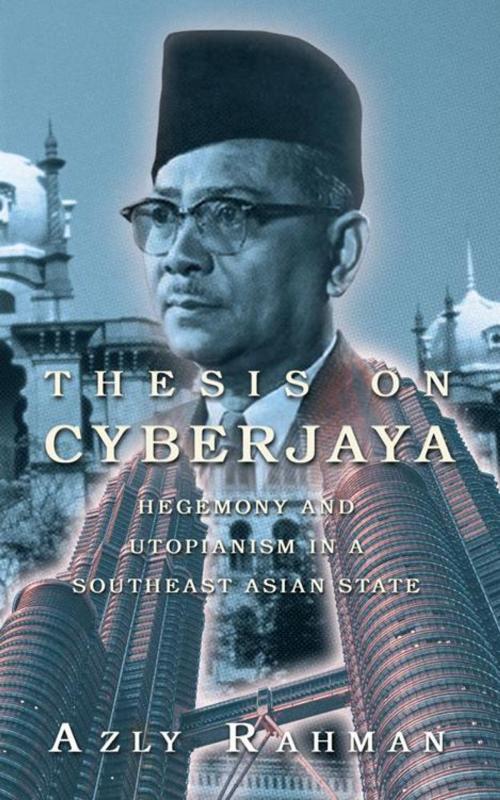Thesis on Cyberjaya
Hegemony and Utopianism in a Southeast Asian State
Nonfiction, Social & Cultural Studies, Social Science, Cultural Studies, Ethnic Studies| Author: | Azly Rahman | ISBN: | 9781468548976 |
| Publisher: | AuthorHouse | Publication: | November 21, 2012 |
| Imprint: | AuthorHouse | Language: | English |
| Author: | Azly Rahman |
| ISBN: | 9781468548976 |
| Publisher: | AuthorHouse |
| Publication: | November 21, 2012 |
| Imprint: | AuthorHouse |
| Language: | English |
THESIS ON CYBERJAYA: HEGEMONY AND UTOPIANISM IN A SOUTHEAST ASIAN STATE by Azly Abdul Rahman a dissertation on "cybernating nations" submitted to Columbia University, New York (2004) This book, maintaine in its original dissertation format explores the concepts of hegemony and utopianism in the conceptualization of a technopole in a Southeast Asian state. I describe how cybernetics flow transculturally and is inscribed onto human consciousness as illustrated in the case of Malaysias grand-scale real estate project: Silicon Valley-inspired Multimedia Super Corridor (The MSC). I focus on the new economic nerve, Cyberjaya and the administrative capital, Putrajaya to investigate the dimensions of hegemony and utopianism My guiding questions were: what variant of hegemony is emerging? And what is the nature of the utopianism involved? Drawing inspiration from dialectical materialism, I designed a mixed-method approach in this study. The ensemble of methods used are Grubers Evolving Systems Approach to the study of an individual, semiotic analysis of visual images, and thematic analysis of speeches. This is a four-part dissertation. In Part I) I discuss the background of this study and review related sensitizing concepts (particularly hegemony and utopianism). In Part 2, I look at the history of Malaysia and the origin of the MSC. Using Grubers Case Study Approach, I then analyze the authoritarianism of Mahathir Mohamad, the author of the MSC project. In Part 3), using semiotics and thematic analyses. I describe how ideology is inscribed by looking at first, how cybernetics mutates with the recipient state, next, changes social relations of production, and finally produces and reproduces consciousness. I explore how foreign industrial and cultural complexes are installed and how they become ideological installations. In Part 4), I discuss my findings, develop propositions, outline a Theory of Hegemonic Formulations and suggest a set of tools to analyze how concepts permeate transculturally. I conclude my study with a reflection on Malaysias MSC after the retirement of Mahathir Mohamad. I propose that hegemony is a complex, kaleidoscopic, and multidimensional yet discernable and analyzable construct. Hegemony operates at the levels of language, politics, and systems of education, and helps define, institutionalize, and ritualize authoritarian leadership. Utopianism is one formulated by ideology, nationalism, and technological determinism. The interplay between authoritarianism and cybernetic systems sustain the culture of hegemony which then helps reproduce newer forms of Oriental Despotism.
THESIS ON CYBERJAYA: HEGEMONY AND UTOPIANISM IN A SOUTHEAST ASIAN STATE by Azly Abdul Rahman a dissertation on "cybernating nations" submitted to Columbia University, New York (2004) This book, maintaine in its original dissertation format explores the concepts of hegemony and utopianism in the conceptualization of a technopole in a Southeast Asian state. I describe how cybernetics flow transculturally and is inscribed onto human consciousness as illustrated in the case of Malaysias grand-scale real estate project: Silicon Valley-inspired Multimedia Super Corridor (The MSC). I focus on the new economic nerve, Cyberjaya and the administrative capital, Putrajaya to investigate the dimensions of hegemony and utopianism My guiding questions were: what variant of hegemony is emerging? And what is the nature of the utopianism involved? Drawing inspiration from dialectical materialism, I designed a mixed-method approach in this study. The ensemble of methods used are Grubers Evolving Systems Approach to the study of an individual, semiotic analysis of visual images, and thematic analysis of speeches. This is a four-part dissertation. In Part I) I discuss the background of this study and review related sensitizing concepts (particularly hegemony and utopianism). In Part 2, I look at the history of Malaysia and the origin of the MSC. Using Grubers Case Study Approach, I then analyze the authoritarianism of Mahathir Mohamad, the author of the MSC project. In Part 3), using semiotics and thematic analyses. I describe how ideology is inscribed by looking at first, how cybernetics mutates with the recipient state, next, changes social relations of production, and finally produces and reproduces consciousness. I explore how foreign industrial and cultural complexes are installed and how they become ideological installations. In Part 4), I discuss my findings, develop propositions, outline a Theory of Hegemonic Formulations and suggest a set of tools to analyze how concepts permeate transculturally. I conclude my study with a reflection on Malaysias MSC after the retirement of Mahathir Mohamad. I propose that hegemony is a complex, kaleidoscopic, and multidimensional yet discernable and analyzable construct. Hegemony operates at the levels of language, politics, and systems of education, and helps define, institutionalize, and ritualize authoritarian leadership. Utopianism is one formulated by ideology, nationalism, and technological determinism. The interplay between authoritarianism and cybernetic systems sustain the culture of hegemony which then helps reproduce newer forms of Oriental Despotism.















